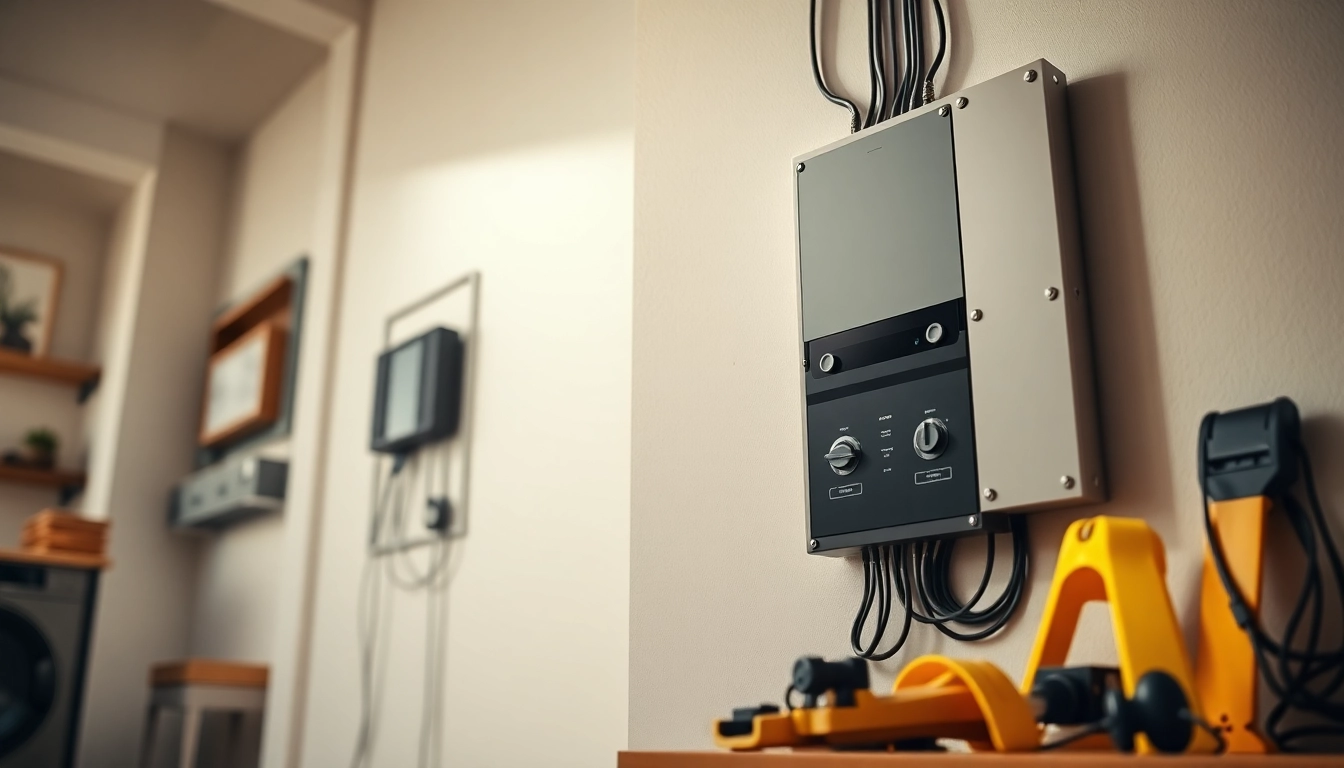What is an Electrical Panel?
Definition and Function
An electrical panel, sometimes referred to as a breaker box or distribution board, is a crucial component of your home’s electrical system. It acts as the central hub that distributes electricity to the various circuits throughout your home. When your electrical system is energized, the panel receives high-voltage electricity from the service line and divides it into manageable circuit breakers that route the power to outlets, fixtures, and appliances.
The primary function of an electrical panel is to provide safe and efficient distribution of electricity while protecting your home from overloads and short circuits. By using circuit breakers, the electrical panel automatically disconnects power to a circuit when it detects an overload, preventing potential fire hazards.
Components of an Electrical Panel
An electrical panel consists of several key components:
- Main Breaker: This is a large switch that cuts power to the entire panel. It allows for the complete shutdown of electricity if needed, such as during maintenance or emergencies.
- Circuit Breakers: These smaller switches protect individual circuits. Each circuit breaker can be reset after an overload occurs, restoring power to the affected area without the need to replace any component.
- Bus Bars: These are conductive metals that distribute electricity to the individual circuit breakers. They connect the incoming supply from the service line to the breakers.
- Neutral Bar: This component serves as a connection point for the neutral wires from various circuits, directing them safely back to the main service line.
- Ground Bar: This serves as the point for all grounding wires, ensuring that any excess electricity is safely channeled to the ground, mitigating shock risk.
- Cover: The panel’s cover protects its internal components from dust, moisture, and accidental contact.
Types of Electrical Panels
There are several different types of electrical panels, commonly categorized by their application and design:
- Main Breaker Panels: The most common residential type, it features a large main breaker and multiple branch breakers for various circuits.
- Main Lug Panels: These panels do not have a main breaker. They are installed where a separate disconnect is required, typically in commercial applications.
- Subpanels: Used to distribute power in different sections of larger properties, these panels draw power from the main panel but allow for separate circuit management.
- Smart Panels: These modern panels offer advanced features, such as energy usage monitoring and integrated smart home capabilities.
Signs You Need to Upgrade Your Electrical Panel
Common Symptoms of Electrical Panel Issues
Homeowners should be vigilant of potential signs that indicate their electrical panel may require upgrading. Some common issues include:
- Frequent Circuit Breaker Trips: If you find yourself regularly resetting breakers, it could signify that the panel is overloaded or that certain circuits are drawing too much current.
- Flickering Lights: This can indicate a poor connection within the panel or that circuits are oversubscribed.
- Burning Smell or Discoloration: Any burning smell or visible charring around the panel is a serious safety concern and warrants immediate inspection.
- Buzzing Noises: A buzzing sound can indicate overloaded circuits, faulty breakers, or more concerning issues that should not be ignored.
Evaluating Your Power Requirements
Over time, the electrical needs of a household can increase significantly due to added appliances, electronics, or other power consumption devices. It’s crucial to evaluate your current power requirements:
- Inventory Appliances: Make a list of high-wattage appliances used in your home. Add up their wattage to see if they exceed the capacity of your current panel.
- Check Amperage: Ensure that your electrical panel has enough amperage to support your household needs. Current standards often recommend a minimum of 200 amps for modern homes.
- User Needs: Consider any additions you plan to make, including home offices, workshops, or entertainment systems that could raise your overall power demand.
Safety Concerns with Older Panels
Older electrical panels, particularly those installed before the 1980s, may pose safety hazards. Components and materials used in older panels may not comply with today’s safety codes. Common concerns include:
- Fuse Boxes: Many older homes still use fuse boxes, which can be less reliable than modern circuit breakers.
- Outdated Breakers: Breakers from some manufacturers, like Federal Pacific and Zinsco, have been flagged for safety concerns due to a high rate of failure.
- Insulation Deterioration: Wires in older panels may suffer from insulation breakdown, increasing shock and fire risks.
Choosing the Right Electrical Panel for Your Needs
Understanding Amperage Ratings
Amperage ratings reflect how much electrical current the panel can safely handle. Here’s what you need to consider when selecting a panel:
- 100 Amps: Suitable for smaller homes or apartments where electrical needs are minimal.
- 150 Amps: Common in average-sized homes with standard electrical needs.
- 200 Amps: Ideal for modern homes, allowing ample capacity for high-energy appliances and systems.
- 400 Amps and above: Typically found in large homes or commercial applications where extensive electrical usage is anticipated.
Breaker Types and Their Functions
Understanding the types of breakers installed within your panel is crucial to effectively manage your property’s electricity:
- Standard Breakers: Protect individual circuits by cutting off power during overloads.
- Double-Pole Breakers: Used for large appliances, such as central air conditioners or ovens, which require more power.
- GFCI Breakers: Ground Fault Circuit Interrupter breakers offer breakpoint protection in areas where water may come into contact with electrical devices, such as kitchens and bathrooms.
- TP Breakers: Intended for circuits where three-phase power is required; used in commercial settings.
Cost Considerations for Upgrading
Investing in an electrical panel upgrade involves several cost considerations:
- Panel Selection: The cost of the panel itself varies significantly based on the brand, amperage, and features. Generally, expect to pay between $500 to $1,500 just for the equipment.
- Installation Costs: Hiring a licensed electrician typically ranges from $200 to $750 depending on the complexity of the installation.
- Permits: Most local governments require permits for electrical work, costing anywhere from $50 to several hundred dollars depending on the jurisdiction.
- Additional Upgrades: Upgrading an electrical panel may also necessitate rewiring, adding circuits, or even grounding systems, further impacting costs.
Installation Process of an Electrical Panel
Hiring a Qualified Electrician
Choosing a qualified electrician is crucial for a successful electrical panel installation:
- Check Credentials: Ensure they are licensed and insured within your state. Verify reviews and ratings online or seek recommendations from friends and family.
- Request Quotes: Before settling on a contractor, obtain multiple estimates to compare pricing, timelines, and project scope.
- Review Experience: Select an electrician who has significant experience in panel installations specifically, as this requires advanced knowledge of electrical systems.
Steps in the Installation Process
- Assessment of Electrical Needs: The electrician will evaluate your electrical usage to determine the correct amperage and features for your new panel.
- Shutting Off Power: Before installation, they will safely shut off the power supply to the existing panel.
- Removing the Old Panel: The outdated panel will be unscrewed and removed from the mounting bracket, along with the connections to the bus bars.
- Installing the New Panel: The new electrical panel will be mounted securely, and connections will be made to the service line.
- Testing: Once installation is complete, the electrician will test the system for proper functioning, ensuring all breakers and circuits operate correctly.
- Final Inspection: Depending on local regulations, an inspection may be necessary to verify that the work meets building codes.
Permits and Regulations to Consider
Upgrading your electrical panel typically requires permits and inspections enforced by local building codes:
- Building Permits: Almost every locality requires permits for electrical work, which ensures that installations meet safety codes.
- Inspections: Local authorities may also require inspections of the work performed. These are systematic checks conducted to validate compliance with safety standards.
- Codes Compliance: Familiarize yourself with the National Electrical Code (NEC) and any state-specific codes that apply to electrical installations.
Maintaining Your Electrical Panel
Routine Checks and Maintenance Tips
Regular maintenance of your electrical panel can extend its lifespan and enhance safety:
- Visual Inspections: Annually assess the panel for any signs of wear or damage, such as rust, discoloration, or burnt areas.
- Check Breakers: Periodically test each breaker by switching it off and back on to ensure they operate correctly.
- Keep It Clean: Dust and debris can accumulate in the panel, potentially leading to overheating. Keep it clean and free from clutter.
Common Issues and Troubleshooting
Being aware of common electrical panel problems can help you address them early:
- Repeated Trips: If a particular circuit regularly trips, it may indicate an issue with the wiring or devices on that circuit.
- Hot Breakers: If breakers feel hot to the touch, this could signal an overloaded circuit or defective breaker, necessitating replacement.
- Voltage Drops: Sudden drops in power levels can indicate problems within the panel or the wiring leading to it.
When to Call a Professional
Some situations require professional intervention:
- Burning Smells or Smoke: If you encounter any burning smells, visible smoke, or flames, contact emergency services immediately.
- Electrical Shock: Any sensation of shock when touching wires or outlets is a strong indicator of underlying issues.
- Unexpected Behavior from Appliances: If your appliances are intermittently failing or behaving erratically, it may suggest a power problem originating from the panel.



